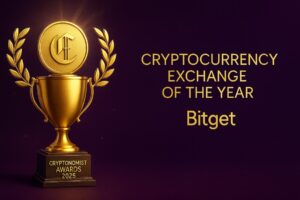August 2025 was a month full of news for crypto, a real roller coaster ride.
At the beginning of the month, the sentiment was euphoric, fueled by news of strong institutional interest in Ethereum and other majors.
However, mid-month some clouds dampened the enthusiasm: Bitcoin began to lose a key technical support, fueling fears of correction and “bull trap” scenarios.
On the macro front, the US inflation for July came out slightly below expectations, momentarily strengthening the narrative of a more accommodative Fed and injecting optimism into the markets. But the effect was short-lived: towards the end of August, attention shifted to the Jackson Hole symposium and Powell’s words, which kept investors cautious (no one wants to be caught off guard if the dollar were to strengthen again). The general market mood thus balanced out to a neutral: no panic but also no wild euphoria.
This is confirmed by the Fear & Greed Index, which has returned to around 47/100 – a signal of an undecided public, caught between FOMO and fear of a retracement.
Crypto news August 2025: markets and prices
Bitcoin (BTC) – After reaching a new annual peak at ~$124,500 at the end of July, Bitcoin started August with a bang only to slide into a correction. Over the course of the month, it lost about 13-14% from the recent record, breaking a multi-year bullish trendline and scaring the market.
From the highs, BTC fell below the $110k mark, ending the month around $108,000. This support break shook some holders, but many “crypto bro” analysts called it a possible fakeout: historically, Bitcoin often tests the weak before bouncing back stronger. Some see potential drops below $100k as buying opportunities in anticipation of a new surge. In short: bull market still alive, but with a shakeout underway to shake off weak hands.
Ethereum (ETH) – Ether experienced a consolidation in August with a more resilient trend. At the beginning of the month, it broke through $4,300 for the first time since 2021, indicating renewed interest. It then closed August just below that level (~$4,374), retaining most of its YTD gains. The main driver?
Institutional demand on the rise: Ethereum ETFs have seen record inflows, increasing from $9.5 billion to $13.7 billion in AUM this month (+44%). After months of underperformance compared to BTC, the second crypto by market cap seems to have regained momentum thanks to the recognition of its use value and adoption (words of the CIO of Sygnum Bank). Key levels to monitor: support area at $4k and resistance at historical highs around $4.8-5k. Growing volumes and an increase in daily transactions on the Ethereum network indicate that interest has returned to “ultrasound money.”
Altcoin: top gainers & losers – Even in August, some altcoins moved spectacularly. Among the top gainers is Cronos (CRO), the token of the Crypto.com ecosystem, which nearly doubled (+95%) in the last week of the month. Pyth Network (PYTH) (+41%) and the mysterious Pump.fun (PUMP) (+12%), linked to an aggressive buyback project, also performed well. On the opposite front, among the worst performers, we find ultra-speculative tokens like SPX6900 (SPX) (-22.7%) and Aerodrome (AERO) (-21.7%), as well as Pendle (PENDLE) (-19%). These fluctuations reflect a market still driven by momentum trading: capital rapidly rotating from one trend to another, often with a hit-and-run logic. Those who caught the right train (see CRO) celebrated, while those left holding the bag on certain meme tokens felt the burn.
Correlation with macro-assets – In August, cryptos danced to the rhythm of macro data. The release of a cooler-than-expected US CPI (annual inflation ~2.7% vs expectations ~2.9%) breathed life into risk-on mid-month, reinforcing the thesis of possible Fed rate cuts by the end of the year. Bitcoin and stocks bounced together on that data. On the other hand, when Powell maintained a cautious tone at Jackson Hole at the end of the month, the dollar strengthened and cryptos cooled off. We also note the persistent decorrelation from gold: while the yellow metal remained stable, Bitcoin showed independent movements, more similar to those of the Nasdaq on risk-on days. In summary, cryptos in August reacted sensitively to every whisper from the Fed and economic data, confirming that the link with macro factors (interest rates, liquidity) is stronger today than ever. One eye on the BTC chart and one on the economic calendar!
DeFi & NFT
Decentralized Finance (DeFi) – The month saw DeFi reach new milestones in terms of locked capital, but not without bumps along the way. On the positive side, August 2025 will be remembered as the month of “Liquid Staking”: the staking economy hit a historic record of $86 billion in TVL across all liquid staking protocols. Half of this figure is credited to Lido, indicating great post-Merge confidence in Ethereum’s staking ecosystem. Now over 29% of all circulating ETH is staked – a sign that many investors prefer to earn returns on their ether rather than keep them idle. Alongside this “virtuous” boom, there were the usual shadows of hacks and exploits: for example, the meme-coin launchpad Odin.fun on the Bitcoin network fell victim to a liquidity manipulation that siphoned off ~58 BTC (about $7 million). A familiar scheme: the attacker artificially pumped the price of a token with their own liquidity, only to withdraw it and escape with the loot. On Solana, a DeFi lender (Credix) also suffered a $4.5M exploit via a compromised admin wallet. In short, TVL and innovation are growing, but risks remain persistent. On the innovation front, it’s worth noting that 1inch launched native cross-chain swaps between Solana and 12 EVM chains, eliminating the need for external bridges – an important step towards an interoperable DeFi world. Additionally, the US SEC clarified that liquid staking does not constitute a security offering, removing a potential regulatory burden from the path of protocols like Lido and Rocket Pool. In summary: August’s DeFi saw more capital, more multi-chain integrations, more regulatory clarity, balanced by incidents that remind everyone not to let their guard down.
NFT & digital collectibles – The NFT market continues its stabilization phase. Trading volumes in August remained moderate or declining – for example, in the last week, global NFT sales dropped by ~13%, settling at $127 million. However, an interesting fact is that the number of buyers has increased (+18% weekly): this suggests that the NFT user base is slowly growing, but with smaller average tickets and less large-scale speculation. In practice, more retail collectors are coming in to take a look, while big traders remain on the sidelines. On the podium of the most popular collections, there were some multi-chain surprises: Courtyard on Polygon, a project that tokenizes physical memorabilia (collectible cards, sneakers, etc.) led the early-August rankings with $12.8M in sales and 166k transactions – thanks to the idea of an NFT linked to real objects stored in vaults, sold with fiat checkout and zero gas. A sort of eBay 3.0 on-chain, indicating that tangible utility can attract new users. Among the Ethereum blue chips, mixed signals: CryptoPunks saw a 65% drop in weekly volume, with just 34 sales, but at the same time, the floor price rose above $200k thanks to a massive purchase of 45 Punks by a mysterious institutional whale. So, few but valuable sales, a sign that diamond hands are holding firm and some are making thoughtful long-term purchases. The Bored Ape Yacht Club (BAYC), on the other hand, experienced a mini-revival: +60% in volume ($5.78M for the week), indicating that some investors see opportunities at “discounted” prices and still believe in the bored apes brand.
Pudgy Penguins are confirmed as steady performers: ~$5M in weekly volume with a very active community and cross-media initiatives (they even have a line of physical toys in major retail). Speaking of intersection with the real world, news on August 29 is that Pudgy Penguins will collaborate with Mythical Games (the ones from FIFA Rivals) to launch a mobile game Pudgy Party: a move that brings an NFT project into mainstream gaming and could open the doors to new users for the collection. Finally, looking beyond Ethereum, a new player emerges: the Mythos Chain, on which DMarket operates, a marketplace for game items (CS2, Dota2, TF2…). DMarket has totaled ~$4.7M in trades in a week with a whopping 170,000 transactions and over 14k buyers – here we talk about NFTs as useful tools (game skins and items) rather than collectible art. A sign that the future of NFTs could pass through utility (ownership of usable assets) as well as scarcity for its own sake. In summary: the NFT market is cooling compared to the heights of 2021, but not dead. Multichain integrations, concrete use cases (physical collectibles, gaming) are multiplying, and solid communities are building brands beyond the fleeting hype.
Memecoin & Community Trend
If you thought the memecoin craze was out of fashion, think again: in August, the “crypto bro” community continued to have fun (and take risks) with quirky tokens. The “serious” star of the month is Dogecoin (DOGE), resurrected in the headlines thanks to an institutional move disguised as a meme. Alex Spiro, Elon Musk’s lawyer, will be the chairman of a new special purpose vehicle aiming to raise $200 million to buy Dogecoin and hold it in reserve. This sort of Doge-Treasury (promoted by the “House of Doge,” which includes the Dogecoin Foundation itself) would give traditional investors a way to gain exposure to DOGE through shares, without having to hold crypto directly. The news gave a boost to Dogecoin’s price, which reclaimed $0.22 at the end of the month after summer volatility. Interestingly, during August, large institutional wallets accumulated over 680 million DOGE, taking advantage of the fluctuations—indicating that not only retailers but also the “big players” believe in the potential of the most famous Shiba-Inu dog on the web. In short, Dogecoin remains a meme but is increasingly less of a joke: Tesla already holds it on its balance sheet for some pocket change, and now publicly traded companies are making it a treasury asset. Much wow!
But the real excitement among the apes was seen with the new emerging meme-coins. Above all, Token6900 (T6900) made noise, a project that mocked every traditional logic by declaring it offered “nothing of value, nor plans for the future” – literally shitpost finance. Yet, this absurd self-irony became its strength within the community. With nostalgic branding in Windows 95 style and 80% of the supply in public presale (zero VC allocations, anti-establishment vibe), Token6900 captured the attention of thousands of retail traders eager for the next 100x. The presale raised a whopping 2.3 million dollars, with over 139 million tokens already locked in staking at 33% APY even before listing – pure madness, a sign of how much the “degen” are willing to bet on cosmic nothingness just to not miss the next train. It all stems from the SPX6900 phenomenon, a memecoin launched in 2023 that saw a surge of over 51,000,000% from its debut, reaching a market cap of 1.7 billion dollars at its peak. Token6900 presents itself as the “spiritual sequel” to SPX, offering ordinary people the chance to get in early instead of chasing gains afterward. Will it be yet another bubble? Hard to say, but in the meantime, veterans cite recent successful presale cases: Wall Street Memes (which raised 74M$ and doubled in value at debut) or Pepe Unchained (a monster presale of 74M$, +130% at launch). The appetite for extreme risk and the hunt for the next Pepe remain very much alive in the community. Naturally, behind the scenes, someone warns that 90% of these meme tokens end in tears – but who can resist the adrenaline of being able to say “I was there” for the next Shiba?
Let’s be honest: meme culture is an integral part of the crypto DNA. In a market where fundamentals matter but only to a certain extent, “vibe over value” is the slogan with which SPX6900 has seduced thousands of anti-system investors, and the same philosophy is fueling the 2025 meme cycle. With Elon Musk tweeting rockets and doggies, and funds being established to accumulate DOGE, the boundaries between joke and reality continue to blur. It’s the (dangerous) magic of community moves: when enough people believe in it as a joke, the joke becomes serious (at least while it lasts).
Regulations & Institutional
In August, the regulatory front delivered historic turns and new challenges, in a continuous tug-of-war between openings and tightening. The key news is undoubtedly the (almost) definitive conclusion of the Ripple vs SEC saga. On August 15, the parties jointly filed to withdraw their respective appeals, paving the way for a final settlement. In practice, Ripple will pay the agreed penalty of $125 million and must comply with certain injunctive terms, but Judge Torres’ July ruling remains valid: XRP is not considered a security when sold on secondary exchanges. Only institutional sales of XRP, as they were conducted in the past, violated securities laws. This is a fundamental precedent for the entire sector: there is finally legal clarity on a significant altcoin, and the SEC collects half the fine but sees the possibility of appealing on the “XRP security” issue fade away. For the US crypto industry, it’s a Pyrrhic victory: Ripple spent years and millions, but now the market has a guideline – and indeed many other cases (e.g., LBRY) have used this case as a reference.
Staying in the United States, progress continues towards the institutionalization of the sector. Already at the beginning of the year, the SEC had (miraculously!) approved the first spot ETFs on Bitcoin and Ethereum, and in August we see the effects: in addition to the boom in Ether funds mentioned above, BlackRock has officially launched its iShares Bitcoin Trust (IBIT), and various spot ETFs are active on traditional exchanges. In short, after a decade of waiting, in 2025 investing in Bitcoin via the stock market is a reality – a sign of how regulators are gradually adapting. Still on the US regulatory front, an important clarification from the Department of Justice is noteworthy: in August, the DOJ issued guidelines that “writing code is not a crime,” referring to the responsibility of developers of decentralized protocols. A stance that has reassured many developers (the ghost of the Tornado Cash case loomed) that publishing open-source smart contracts does not in itself put handcuffs on your wrists. In parallel, Congress is discussing various pro-crypto legislative proposals, but the clash is heated (see Sen. Elizabeth Warren vs Sen. Tim Scott on the Crypto Policy Bill). Nothing has been finalized for now, the 2024 election year will be decisive.
Moving to Europe, the gradual implementation of the MiCA regulation continues: from January 2025, the registration requirement for crypto operators will come into effect, and by the end of 2025, the first official licenses will arrive. In short, the EU is swiftly moving towards a unified regulatory framework. August itself did not bring new laws, but the players are preparing: ESMA and local authorities have begun publishing guidelines to standardize the application of MiCA. Meanwhile, in the United Kingdom, there is a less friendly climate: a survey revealed that 4 out of 10 Britons active in crypto have experienced blocked or delayed payments from their bank when trying to transfer funds to exchanges. Giants like Chase UK and NatWest have added strict restrictions, justifying them with the high rate of crypto-related scams. The result? One-third of affected investors have filed an official complaint, and over a third have changed banks to find a more “crypto-friendly” one. The situation is sparking a heated public debate across the Channel between those who accuse banks of stifling innovation (and financial freedom) and those who defend them as guardians against fraud and volatility. It’s the usual tug-of-war between adoption and regulatory caution.
From the rest of the world, mixed signals are arriving: Japan has taken a historic step towards the acceptance of stablecoins, with the regulatory body FSA ready to approve in the fall the first privately issued yen-pegged stablecoin (JPYC). This 1:1 stablecoin with the yen, collateralized by bank deposits and Japanese bonds, represents a paradigm shift for a country that had so far banned foreign stablecoins – and could increase the demand for JGB if adopted on a large scale. Wyoming in the USA continues to act as a crypto laboratory: in August, the state officially launched the Frontier Stable Token (FRNT), a public stablecoin collateralized at 102% by US T-bills, with support from Visa, and distributed on as many as 7 blockchains including Ethereum and Solana. The idea of a federal state issuing its own stablecoin is revolutionary (albeit on a small scale) and shows how certain jurisdictions are ready to innovate by integrating crypto and traditional finance.
On the pure institutional front, August saw significant moves: Tether, the world’s largest stablecoin issuer, hired Bo Hines – former director of the White House Crypto Council under Trump – as a strategic advisor for the USA. A move that underscores Tether’s ambitions to have a say in Washington and comply with future regulatory standards (they have already invested $5 billion in the US economy and aim to strengthen relations with regulators). On the traditional banking front, Google made waves by increasing its stake in the miner TeraWulf from 8% to 14%, investing another $1.4 billion and bringing the total invested in the project to $3.2 billion. Seeing a tech giant invest so heavily in Bitcoin mining is a strong signal of industrial validation (as well as an energy and data center deal for Big G). S&P Dow Jones Indices has also begun discussing partnerships to tokenize its main stock indices, indicating that the boundaries between Wall Street and blockchain are becoming increasingly thin. Furthermore, Polkadot has created a Capital division to connect traditional finance with its ecosystem, while Two Prime (a SEC-registered advisor) has partnered with Figment to offer institutional clients access to crypto yield on 40+ protocols. In short, mainstream companies – from banks to tech companies – are increasingly entering our sector with investments, partnerships, and dedicated products. Amidst many openings, regulatory gray areas still exist: in some countries, bans or obstacles remain. China, for example, continues its ban on retail crypto trading, while developing its own CBDC. But globally, the trend is clear: institutionalization and regulation are making the crypto world more mature. August 2025 gave us a concrete taste of this, between the end of an epic legal battle (Ripple) and the arrival of new rules and players. The message is clear: “crypto is here to stay, but it will no longer be the Wild West” – and it’s time to build bridges with the traditional financial system, without betraying the innovative spirit that made it great.
Tech & Innovation
This month, the blockchain sector has continued to experiment and innovate comprehensively, with a focus on scaling, new chains, and intersections with AI and gaming.
Layer 2 and new chains – Scalability remains the watchword. In August, Base, Coinbase’s recently launched Layer 2 network, made headlines: within 30 days, it already entered the top 3 for NFT volume with $47.7M in trades (+70%), surpassing Solana and Immutable X during the period. A remarkable feat that shows how L2s are gaining traction not only for DeFi but also for collectibles and social apps (on Base, for example, the Friend.tech phenomenon exploded). Ethereum, for its part, continues to evolve: at the end of August, the Ethereum Foundation unveiled the 2024-2026 roadmap, focusing on drastically improving speed, security, and interoperability through rollups and zk-proof. Much of the attention is on the upcoming “Dencun” upgrade, which will include EIP-4844 (proto-danksharding) to make L2 fees even cheaper and bring us closer to a large-scale “data-available” Ethereum. There’s also excitement on the new chain front: none other than Google Cloud has unveiled its Google Cloud Universal Ledger (GCUL) project, a layer 1 blockchain designed for financial institutions with smart contracts in Python language. Developed in collaboration with CME Group, GCUL aims to offer neutral and interoperable infrastructure for tokenization and wholesale payments, with trials already underway to bring margin and collateral regulations to a 24/7 mode. It’s impressive to see giants like Google, Circle, and Stripe building their proprietary chains; a future is envisioned where public permissionless blockchains and dedicated enterprise ledgers coexist, possibly interconnected. A signal in this direction: Chainlink in August launched the Data Streams service that brings real-time stock and ETF prices directly on-chain, already integrated by DeFi protocols like GMX – a direct bridge between traditional finance and smart contracts that will be extremely useful precisely on those institutional chains.
AI and Crypto – The convergence between artificial intelligence and blockchain, two very hot worlds, continues. In the first 8 months of 2025, crypto projects in the AI field have raised $516 million in funding, already a +6% compared to the entire 2024. Funds like Bitwise, Pantera, Sequoia, and Binance Labs are actively investing in startups that merge AI agents with tokens and decentralization. The underlying idea is that AI is creating “new asset classes” – datasets, trained models, autonomous agents – that can be owned and traded on-chain. For example, Coinbase has launched the “x402” protocol for stablecoin payments between AI agents on the internet. Solutions are being explored where blockchain helps democratize access to computational power, currently dominated by a few big cloud players: projects like Render Network (RNDR) aim to leverage unused GPUs worldwide to provide decentralized AI computing services. Certainly, there is a scent of a bubble – even Sam Altman (OpenAI) has warned that many AI investors will lose money, and 95% of corporate AI pilots do not bring significant revenues. But the desire to innovate does not stop: in August, crypto and AI leaders (like Vitalik, Altman, etc.) even joined forces to create a policy education group in the USA, a sign that the two sectors see an intertwined destiny even on the regulatory front. In short: AI and crypto are converging, and if AI truly adds trillions to the global GDP (some estimate +$20 trillion by 2030), blockchain wants to be the ledger on which a slice of that digital wealth will be created and exchanged. Get ready to hear terms like “AI tokens,” “decentralized AI,” and similar more and more often.
Gaming and Metaverse – While the “metaverse” hype of the past has deflated, the integration between crypto and mainstream gaming continues more quietly. Besides the already mentioned example of Pudgy Penguins entering mobile gaming, other projects aim to bring traditional game assets onto the blockchain. The mentioned DMarket/Mythos platform that tokenizes items from CS:GO, Dota 2, Rust, etc., is a success story: real volumes and users, not speculators. Animoca Brands has also launched new play-and-earn titles, and many video game companies are exploring interoperable cosmetic NFTs across titles. An interesting fact: the Mythos chain and Polygon are demonstrating that gamers can use NFTs without even realizing it (fast transactions and minimal fees). This trend of “Web3 gaming” is evolving into hybrid forms: no longer the infinite Axie model, but cases where NFTs and crypto add optional value to games for those who want it (collectibles, tournaments with crypto prizes, etc.). Meanwhile, the development of open metaverse platforms like Decentraland and Sandbox continues, although media clamor is less. Also noteworthy is the Worldcoin experiment (the “orb” for iris scanning for decentralized identities) which continued to spark debate in August – several local authorities blocked biometric scanning due to privacy concerns, but the WLD token remains heavily traded. In general, tech innovation in the crypto sector does not stop: from new languages for smart contracts (see Move used by Sui and Aptos, or Account Abstraction on Ethereum that enables smart wallets and social recovery), to progress towards privacy (increasingly efficient ZK protocols, privacy-oriented layer1s like Aleo in advanced testnet). Vitalik Buterin also issued a warning at the end of August: the rise of quantum computers could undermine the cryptographic foundations of blockchains, urging investment in quantum resistance now. In short, the technology behind crypto is a bustling construction site. The intersection with AI, gaming, and traditional finance is giving us a new wave of ideas and solutions. The true “buidlers” continue to build, away from price noise: the fruits of this work will be fully seen in the coming years, but August gave us several interesting previews of that future on the horizon.
Top News of August 2025
End of the Ripple vs SEC lawsuit: The long legal battle is nearing its conclusion. On 08/15, Ripple and the SEC filed a joint request for the dismissal of all appeal cases, effectively accepting the first-instance ruling. Ripple will pay a $125M fine and must comply with certain conditions, but it remains that XRP is not a security on secondary exchanges. Case closed (awaiting only the formal signature of the Court of Appeals) and a landmark for crypto in the USA.
Bitcoin loses a key support: After reaching new annual highs above $124k, Bitcoin at the end of August fell below the historic multi-year bullish trendline, causing turmoil in the market. The price dropped below $110k, fueling fears of a bearish reversal. Some analysts speak of a simple technical correction or fakeout, indicating the $100k range as a floor and potential springboard for the next leg up, but investor attention is at its peak: Bitcoin must hold the line.
Dogecoin becomes “institutional”: Elon Musk is once again a key player in the DOGE ecosystem. His lawyer Alex Spiro will chair a new $200M public fund dedicated to holding Dogecoin as a treasury asset. The initiative (revealed by Fortune) will allow exposure to DOGE via the stock market, without directly owning crypto. The news has driven Dogecoin to rally to $0.22 and marked an unprecedented union between memes and traditional finance.
DeFi in boom: staking record and new hacks: All Time High for DeFi thanks to liquid staking – reaching $86 billion in aggregated TVL on 08/14, up 48% since the beginning of the year. Over 29% of all ETH is now in staking, a sign of confidence post-Shanghai and appetite for on-chain yields. On the flip side, the month saw yet another exploit: the launchpad Odin.fun was hacked for ~58 BTC (~$7M) by exploiting liquidity manipulation of a meme-token. DeFi is increasingly wealthy, but security remains an ongoing challenge.
Big Tech launches its blockchain: Google enters the scene with Google Cloud Universal Ledger (GCUL), a layer1 blockchain developed for financial institutions and enterprises, with smart contracts in Python. Presented with CME Group, it aims at use cases of tokenization and 24/7 payments. The fact that giants like Google and Stripe are creating proprietary blockchains indicates how serious the race for enterprise Web3 infrastructure is. Meanwhile, S&P Dow Jones has announced plans to bring its stock indices on-chain, further signaling the convergence between traditional and crypto markets.
(Bonus) Other noteworthy news: Tether recruits a former White House advisor (Bo Hines) to push the US strategy; Ethereum ETFs are recording record inflows ($13.7B AUM) while UK banks block crypto payments causing customer protests; Bernstein predicts a crypto bull market well beyond 2025, with Bitcoin at $150-200k by 2026; UK teeters between innovation and fears: a sandbox for crypto is ready but meanwhile the FCA tightens on the promotion of digital products.
Outlook for next month (September 2025)
September is shaping up to be a crucial month, suspended between potential bull catalysts and risks to watch out for. Here are the scenarios and key factors for the next 30 days:
Central Banks & Macro: All eyes on the Fed. In mid-September, the FOMC will decide on rates – in August, markets attributed ~40% probability to a rate cut, but Powell’s communication remains cautious. If the Fed were to surprise in a dovish manner (even just signaling a stop to hikes or future easing), we could witness a general rise in crypto on the wave of new liquidity and risk appetite. Conversely, a hawkish message (or rising inflation data in September) would strengthen the dollar and could exert bearish pressure on Bitcoin & co. In Europe, attention to the ECB and decisions on the cost of money: a weak or strong euro indirectly impacts global sentiment. In summary, macro narrative still the primary driver: “Crypto bros, watch the Fed!”.
Technical levels to monitor: For Bitcoin, the $100k area is the psychological and technical watershed level. If September sees BTC holding above this threshold and possibly reclaiming 114-120k, the bullish structure remains intact. Below 100k, the path to further corrections would open up (next strong support area is 80k according to some models). Ethereum has its test at $4,000 – so far it has shown strength, but it needs to push towards 4.5-5k to confirm a breakout of the old ATH. In case of slips, the $3600 area is the main support. Many major altcoins (Solana, BNB, ADA) are consolidating; a market resurgence could see them outperform BTC (typically in mature bull markets, alts tend to run more). But if Bitcoin falters, expect BTC dominance to rise and altcoins to suffer relatively. September is historically a challenging month for markets (including traditional ones), so caution is advised: do not chase pumps and consider stop-losses.
On-chain events and sector: A technical factor not to forget: in September, tokens worth approximately $4.5 billion will be “unlocked” (vesting expiration on various projects). We are talking about a potential increase in sellable supply on the market – among the main cases are significant cliff unlocks of tokens from DeFi platforms and Layer1. This could generate selling pressure on some assets on the unlock dates. Those operating on specific tokens would do well to inform themselves about vesting calendars to avoid being flooded with sudden supply. On the derivatives front, pay attention to the expiration of futures and options contracts at the end of the quarter (September marks Q3): volatility often increases, and we witness short/long squeezes.
News and narrative: Possible positive developments could come from the US ETF sector: the SEC will have to decide on some crypto ETFs (there are rumors of ETFs on other altcoins in the pipeline). Approval of new traditional investment products would be welcomed as bullish news. Keep an eye on Ethereum ETF futures coming soon and the start of the MiCA approval season in Europe (some companies will try to obtain EU crypto licenses as early as Q4). On the adoption front, on September 12, Apple will launch the new iPhones – rumors suggest possible crypto integrations (e.g., support for Bitcoin Lightning in the wallet?) which, if confirmed, would make waves. Additionally, we are awaiting updates on PayPal USD (PYUSD), the stablecoin launched in early August: September could see its first large-scale uses or partnerships, fueling the narrative of big tech embracing crypto. Finally, on the regulatory front: in the US, the House Financial Services Committee might discuss the stablecoin bill and Market Structure Bill post-recess; any legislative progress in the fall would impact sentiment (even though final approval remains distant).
Opportunities and strategies: In this mixed context, the keyword is flexibility. Short-term traders will monitor macro signals and follow volumes – a return of high volumes on spot exchanges or CME futures would be a sign of an accelerating trend (up or down). Medium-term investors may see any September dips as accumulation opportunities: “buy the dip” remains valid if one believes the bull market is still ongoing. And many authoritative voices say so: Bernstein, for example, sees a prolonged bull market until 2027, with Bitcoin heading towards $150-200k by next year and a rally extending to Ether, Solana, and DeFi tokens. This optimistic view (which implies far surpassing the old BTC ATH) suggests that maintaining exposure makes sense, provided there is risk management. The greatest opportunities might arise precisely in those trending sectors: Ethereum and L2 if institutional inflows continue, liquid staking tokens if rates drop (more appeal for on-chain yield), or some alt L1 (like SOL) which, according to Bernstein, could benefit from bitcoin-like treasury strategies but with additional yield. Furthermore, pay attention to the AI-crypto trend: if markets hold, tokens linked to artificial intelligence could come back into vogue in the fall (many projects are about to release updates and mainnets). Similarly, the gaming/NFT sector could have its moment with the release of new pre-announced Web3 games.
Risks to monitor: On the risk side, in addition to macro uncertainties, the security/hack front should be kept in check – every month we witness multimillion-dollar thefts, a mega-hack on some bridge or protocol could undermine trust (remember September 2020 with the KuCoin hack, or October 2022 “Hacktober” DeFi). The dormant whales: some on-chain analyses show historical wallets that have started moving BTC/Eth after years – if they decide to sell en masse, it could trigger sudden downturns. Finally, regulation: as much as it is priced very poorly, tail-end risks remain possible (e.g., the SEC has yet to rule on Binance and Coinbase in court; negative news there would cause a chill). In Europe, from January, the ban on anonymous services for crypto >1000€ will come into effect: exchanges might start to comply in Q4, causing some friction with unverified users.
In conclusion, the next month plays an important game: if the market withstands the challenges of September, it could consolidate the narrative of a lasting bull market and continue the positive trend towards the end of the year. On the contrary, if negative volatility prevails, it’s better to fasten your seatbelts – but always remember that every dip in a bullish cycle is historically a disguised opportunity. The best approach will be to maintain clarity: no panic during downturns, no blind euphoria during upswings. Monitor key indicators (Fed rates, dollar strength, on-chain volumes) and balance the portfolio accordingly. As always, stay safe and enjoy the ride! The crypto world never sleeps, and even in September, we’ll have plenty of fun.









